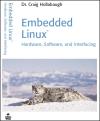Article: Introducing “Embedded Linux: Hardware, Software and Interfacing”
Mar 22, 2002 — by LinuxDevices Staff — from the LinuxDevices Archive — 2 viewsEighteen months ago, Antec Corporation began to investigate incorporating SNMP within their cable television distribution equipment. They wanted to move away from proprietary and home-grown protocols and offer products capable of TCP communication with network management software. With volume in the 1000's, they required a low-cost, reliable, robust, and open solution. I suggested embedded Linux. …
To use Linux in your design, download and compile source code, boot your target hardware, write some device drivers, and then create your application. Sound simple enough? However, from a practical perspective, there are probably a thousand steps involved. I began learning about embedded Linux by reading various HowTos, the documentation from Linux hardware projects, the device driver book, and the enormous wealth of information at LinuxDevices.com. As I pursued this quest, I became aware of a recurring question on mailing lists and in newsgroups: “I want to use Linux in my design. I read everything I could find but I still have no idea where to start.” That's why I decided to write a book on embedded Linux; in my book, I tell you where to start.

I created Project Trailblazer to explain embedded Linux within the context of an example. Seeing how Linux is used in that design will help you with yours. Each Project Trailblazer design decision and interface circuit was carefully crafted to expose various aspects of embedding Linux. For example, I specifically chose the ARM and PowerPC architectures, in addition to the x86, to demonstrate cross-compiling, CPU register configuration, and the use of on-board controllers. I intentionally kept the hardware designs and device drivers as simple as possible, allowing you to focus on a particular topic. When you are finished reading the book, you will have a better understanding of how to use embedded Linux.
Here is my advice: buy the book and read about Project Trailblazer. Follow the engineers as they implement their design. Download the source code and try the examples. Incidentally, you don't actually need the target hardware for all the examples; that old 486 computer collecting dust in the garage, or even your desktop machine, will work just fine. Chapter 7, “Parallel Port Interfacing,” and Chapter 11, “Using Interrupts for Timing,” offer hands-on examples of PC interfacing and device driver development. Get a feel for embedded Linux. Is it right for your next project?
Linux brings reliability, features, open source code and a proven track record to the embedded world. Embedded Linux: Hardware, Software and Interfacing will help you get started.

This article was originally published on LinuxDevices.com and has been donated to the open source community by QuinStreet Inc. Please visit LinuxToday.com for up-to-date news and articles about Linux and open source.